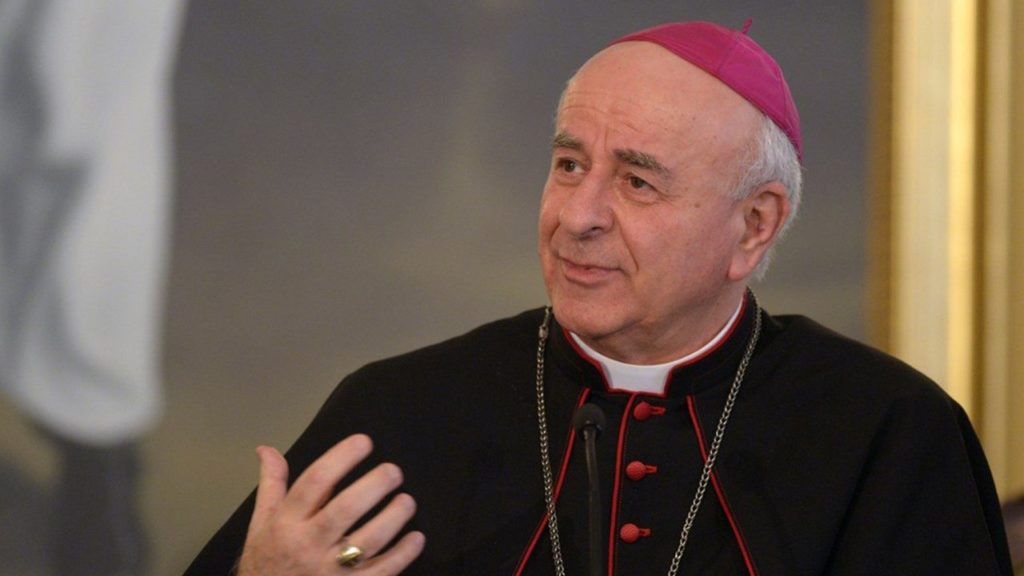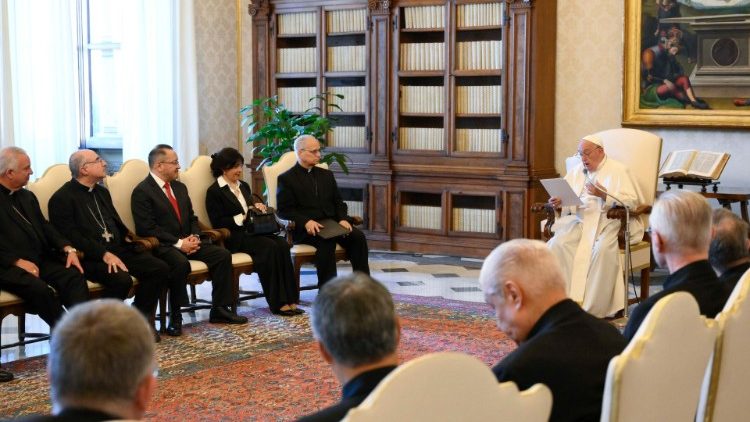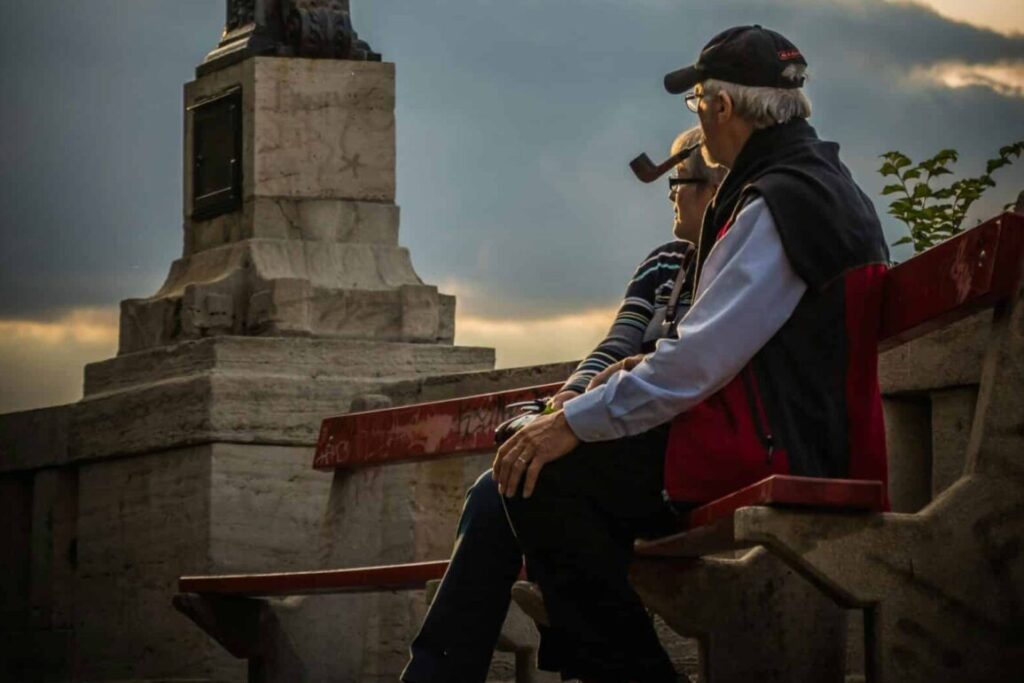Presentation: Assembly of Pontifical Academy Life
'Public Health in a Global Perspective: Pandemic, Bioethics, Future'

On Tuesday morning, September 28, 2021, the Conference took pace live of the presentation of the Assembly of the Pontifical Academy for Life, underway from September 27-29, whose theme is “Public Health in a Global Perspective: Pandemic, Bioethics, Future.”
Intervening during the press conference with the media were Monsignor Vincenzo Paglia, President of the Academy; Dr. David Barbe, president of the World Medical Association (AMM) and Professor Maria Chiara Carrozza, President of the National Research Council (CNR).
Public Health as Background
The first speaker was Monsignor Paglia, who said that this “Assembly is not on the pandemic, but on what we have learned from the pandemic and on what lines we must commit ourselves for a new future. In fact, from the beginning, the Pontifical Academy for Life tried to understand the changes the pandemic was causing in the global society.”
Likewise, he said, the Academy “claims to put Public Health at the center of the debate. Never before did we realize to what degree the health of every person is linked to that of all: we are all inter-connected, for good or bad. Now the privilege of some is no longer sustainable, without it penalizing others. The differences, disparities, and inequalities deny this fundamental evidence and, therefore, they must be overcome.”
The “We” of the Human Family
Quoting Pope Francis’ Fratelli Tutti, the President of the Academy stressed that “we form part of one human family and no one can save himself alone. Therefore, it’s necessary to identify the circumstances of our relations that lead to maintaining areas of wellbeing for a few, to detriment of the many. The hyper-individualistic ’I’ must give way to the ‘we’ of the human family.
“Although the vaccines are the priority of Western countries, we must not forget the need to build just health on a global scale. What is at stake is the future of care and health if we want to take seriously the lessons of the pandemic. For the majority of the world population, the priority is not only the vaccines but also real and effective access to the treatments and the goods that “simply’ allow one to live,” he argued.
The Archbishop also urged not to forget the first lesson. “To take care of health, one must first be alive. And access to the essential goods to live is guaranteed for all on our planet.” For the Academy, he concluded, it’s about “collaborating with the Holy See’s Dicasteries in the framework of the COVID-19 Vatican Commission, and to put the pandemic crisis at the center of attention, proposing a wise interpretation that will illumine the paths of the men and women of our time.”
To Provide Supplies to Every Country
At the beginning of his talk, Dr. Barbe addressed the true gravity of COVID in the society: “The elderly, the chronically ill and some of the non-Caucasian races. These groups had higher rates of serious illness and death, in part due to natural susceptibility; however, the most important thing is that these groups are groups that are experiencing health inequality including in non-pandemic times.”
In this line, he also mentioned the medical staff of the Association, which has been especially affected, so that he invited to find “the way for each country to develop reserves and chains of supply of personal protection equipment as well as the medications and materials necessary to attend a wave of patients in pandemics and other natural disasters or those caused by men.”
Opportunity for Scientific Research
Another area of opportunity, said the AMM’s President, is “science and research and the exchange and diffusion of information. Even today, almost two years after this pandemic, there continues to be controversy and contradictory recommendations on the use of antivirals, neutralizing antibodies, immune modulators, Corticosteroids, and also respiratory assistance. In this time of live global communication, we must improve our collaboration and scientific communication.”
“Until a sickness can be treated effectively, its prevention is fundamental. The vaccines give that opportunity of prevention. Although the efforts to develop and distribute the vaccines against COVID have been monumental, the rates of vaccination, especially in the low and middle-income countries continue to be shamefully low, with rates of vaccination in dozens of countries that are still lower than 3% of the population. This is a multi-factorial problem, “ he said.
Indecision Re Vaccination
Barbe ended his intervention highlighting a last gave factor: indecision re vaccines. “A certain degree is observed in almost all countries and it’s also a multi-factorial problem. The speed with which these vaccines were developed and the new technologies that some of them use, such as the ARNm technology, has made many approach the vaccines with a certain apprehension and even fear.”
Something that has been aggravated by “the global network of disinformation and distortion in regard to the risks and benefits of the vaccine. The cases of adverse effects after vaccination, the concern over the diminution of immunity, and the probable need for subsequent boosters have contributed to the indecision.”
“Doctors and other health professionals are the most reliable voices. Valid and transparent information must continue to be promoted; the benefits of the vaccine must be stressed and also the significantly greater risk of the natural sickness. The tragedy of these and other problems of this pandemic is that many of them were and are avoidable or correctible. It’s said that opportunities are born of crises. If this is true, a great crisis should lead to an even greater opportunity,” he concluded.
Focus on the Most Fragile
Carrozza gave the last talk, pointing out that the “study oriented to people’s health cannot have an exclusively applicative imprint. On the contrary, it is, in fact, the essential research from which the most interesting therapeutic and pharmacological developments stem, as the pandemic demonstrates, in which only thanks to essential research carried out over many years have we been able to produce and distribute vaccines in record time.”
“Scientific research and technological innovation, which are really at the service of people and of the community, must be directed in the first place to the most fragile groups, the people in greatest need of assistance and the last. The logic that fragility and different capacities (. . . ) are a sort of doom of fate must be abandoned, whose burden must be endured only by those directly affected and their carers, that is, almost always their families,” he said.
Translation by Virginia M. Forrester
The following are their interventions, and the intervention of Professor Jules Hoffmann, winner of the Nobel Prize for Medicine in 2011, handed to those present in the room:
Intervention of Archbishop Vincenzo Paglia
This Assembly of the Pontifical Academy for Life – the twenty-seventh assembly since 1994, the year the Academy was founded – has as its theme Public Health in Global Perspective. Pandemic, Bioethics, Future. This is not an Assembly about the pandemic, but about what we have learned from the pandemic and what guidelines we should follow and practice for a new future. Actually, from the very beginning, the Pontifical Academy for Life sought to understand the changes that the pandemic was causing in global society. A series of documents brought to everyone’s attention the considerations that were being expressed from time to time. The first document was dated March 30, 2020: Pandemic and Universal Brotherhood, followed by a second document dated July 22, 2020, entitled Humana Communitas in the Era of the Pandemic. Our reflection then focused on the most severely affected groups, which are the elderly, people with disabilities, and children, with three documents: Old Age: Our Future dated February 9, 2021, Covid-19: Learning from Persons with Disabilities dated June 15, 2021, and the forthcoming document on children.
Following this path, this General Assembly, which includes the participation of our Academicians both on-site and online, and a workshop with some of the leading international experts, intends to put Public Health at the center of the debate. We had never understood so well how much the health of every single individual is connected to the health of all individuals as in the last period: we are all interconnected, for better or for worse. The privilege of some people at the expense of others is no longer admissible. Differences, disparities, and inequalities deny this fundamental evidence and must therefore be overcome.
The backdrop of the Assembly remains Pope Francis’ Encyclical Fratelli Tutti: we are part of a single human family and no one will be able to save themselves on their own. It is, therefore, necessary to identify the dynamics in our relationships that lead to maintaining “areas of well-being” of the few, at the expense of the many. The hyper-individualistic “I” must give way to the “We” of the human family. This is a need that the message of the Gospel illuminates, but it is also inscribed in the horizon of a global society based on relationships of solidarity and global balances so that no one is excluded. There is a need for a new vision of the global human family.
As Pope Francis told us yesterday: «If we examine life expectancy – and healthy life expectancy – in different countries and in different social groups, we find out strong inequalities. These inequalities depend on variables such as level of income, educational qualification, neighborhood (even within the same city). We affirm that life and health are equally fundamental values for everyone, based on the inalienable dignity of the human person. However, if this statement is not followed by the appropriate commitment to overcome inequalities, we actually accept the painful reality that not all lives are equal and health is not protected for everyone in the same way. And here I would like to reiterate my concern, so that there will always be a free health care system: the countries that have it – for example Italy and others, which have a good free health care system – must not abandon it, because otherwise, it would come to the point that, within the population, only those who can pay for it will have the right to health care, the others will not. And that’s a very big challenge. That helps overcome inequalities».
If the priority for Western countries is vaccines (and we are actually witnessing the greatest vaccination effort ever made in history), we must not forget the need to build equitable healthcare on a planetary scale. The topic at the center of our reflection is the future of treatment and healthcare if we really want to take seriously the lesson we have learned from the pandemic. For the majority of the world’s population, in addition to vaccines, the priority is real and effective access to care, but also to the goods that “simply” allow us to live. It is necessary to overcome not only the vaccination divide but also the unequal access to public health, removing barriers such as the lack of facilities and managing more wisely the resources for treatment.
Many emphasize the need to respond to the current crisis with measures that are also useful for the future of the planet. Vaccination is crucial for a global protection against Covid-19, but the key issue concerns the possibility of truly overcoming the inequalities soon, by implementing a global health policy that makes access to care more equitable.
Let’s not forget the first and most important lesson: to take care of our health, we must first of all be alive! And access to the essential goods for living must be guaranteed to everyone on our planet.
For the Pontifical Academy for Life, there is a further commitment: to collaborate with the Vatican Dicasteries – in particular within the framework of the Vatican Covid-19 Commission – and to focus attention on the pandemic crisis, proposing a sapiential interpretation that illuminates the paths of men and women in our time. Only together, as brothers and sisters, will we be able to emerge from this crisis. Thank you.
Intervention of Dr. David Barbe
Thank you for the opportunity to comment on the Workshop we have just concluded that looked at many aspects of the COVID-19 pandemic. As President of the World Medical Association, I had the privilege of bringing the physician’s perspective to the discussion.
The severity of COVID varied widely, but the disease severity was greatest in three broad categories: the elderly, those with chronic disease, and some of the non-Caucasian races. These groups had higher rates of severe disease and death in part due to natural susceptibility, but as importantly, these are the groups that experience health inequity even in non-pandemic times. During this pandemic, many in these groups did not have access to early testing and supportive care or hospitalization when their level of disease required it. This pandemic shined a very bright light on the health inequities that exist and must be addressed now.
Our health care workforce was uniquely impacted by this pandemic. In the early days, physicians and other healthcare workers were often expected to care for patients with COVID without the benefit of sufficient personal protective equipment placing themselves at great personal risk. While they continued to deliver care because of their dedication and commitment to patients, many felt unsupported or even betrayed by their hospitals and governments. Many became sick and died as a result. We must find ways for each country to develop stockpiles and supply chains for personal protective equipment as well as medications and supplies needed to care for a surge of patients in pandemics and other natural or man-made disasters.
Another area of opportunity is around the science and research and the sharing and dissemination of information. Even today, almost 2 years into this pandemic, there continues to be controversy and conflicting recommendations about the use of antivirals, neutralizing antibodies, immune modulators, corticosteroids, and even respiratory support. In this age of real-time global communication, we must improve our scientific collaboration and communication.
Unless or until a disease can be effectively treated, prevention is critical. Vaccines offer that opportunity for prevention. While the efforts to develop and distribute COVID vaccines have been monumental, vaccination rates, especially in lower-income and lower-middle-income countries remain embarrassingly low with vaccination rates in dozens of countries still less 3 % of their population. This is a multifactorial problem. Affordability at both the country and individual levels accounts for much of the disparity. However, inadequate vaccine administration infrastructure including both logistics and health system structure as well as vaccine hesitancy contribute significantly in many countries.
The final and maybe the most difficult to understand factor is vaccine hesitancy. This is seen to some degree in nearly all countries and is also a multifactorial problem. The speed with which these vaccines were developed and the newer technologies some of them employ, such as the mRNA technology, have caused many to approach the vaccines with some apprehension and even fear. This has been compounded by the global network of misinformation and distortion regarding the risks and benefits of the vaccine. Breakthrough cases after vaccination, the concern of waning immunity, and the likely need for subsequent boosters have all contributed to the hesitancy. Taken together, these have caused skepticism and doubt regarding the “science” around the vaccines and the recommendations of the medical establishment that is unprecedented. Physicians and other health professionals are the most trusted voices. We must continue to promote valid and transparent information, stress the benefits of the vaccine, and continue to point out the significantly greater risk of the natural disease.
The tragedy in these and other issues in this pandemic is that many of them were and are either avoidable or correctable. It is said that out of crises come opportunities. If so, a great crisis should lead to even greater opportunity.
I commend the Archbishop and the Pontifical Academy for Life and all those who participated in this Workshop for their commitment to capitalize on the great opportunity this gives us to come together to develop solutions and propose concrete actions that can be taken now to address the current crisis and prepare more effectively for the next.
Thank you for your coverage of this Workshop and the very important work being done to combat the ongoing COVID-19 pandemic. Thank you.
Intervention of Professor Maria Chiara Carrozza
We live in the digital economy, ruled by platforms. My dream is that those platforms can be best used in the two fields I care about most: education and healthcare.
Studies aimed at enhancing people’s health cannot have an exclusively applicative approach; on the contrary, it is precisely from fundamental research that the most interesting therapeutic and pharmacological developments come, as demonstrated by the pandemic in which we are now able to produce and distribute vaccines in record time only thanks to fundamental research carried out over many years.
Another important point to make on this subject is that scientific research and technological innovation that are truly at the service of people and the community must look at the most vulnerable groups, the people most in need of care, the last ones, as their first target audience. It is necessary to abandon the logic according to which frailty and different abilities, conditions that are now very common in contemporary societies, also due to increased longevity, are a sort of doom, the burden of which must weigh only on the shoulders of those directly concerned and their caregivers, that is, most of the time their families. Frailty and different abilities are social issues, that is, disadvantaged conditions that the entire community must take on in order to remedy the situation, starting with those who have the skills and knowledge to develop systems that help bridge these gaps.
In this respect, let us consider my area of study – bio-inspired robotics, bioengineering, and artificial intelligence – which has a very wide range of applications in clinical settings: cybernetic implants, exoskeletons, brain-computer interfaces, wearable sensors… Just think of the development of the exoskeleton for neuro-rehabilitation and personal assistance.
In Italy, data show that the attitude towards research is generally positive but contradictory; even during the pandemic, we have had fluctuating feedbacks, with crises due to the feelings of uncertainty that citizens have because of the plurality of scientific voices reported by the media. This point, however, warns us of how complex it is to achieve correct and effective science communication.
Thank you for your attention.
Intervention of Professor Jules Hoffmann
At the end of 2019/beginning of 2020, a severe infection of the human airways was detected in Wuhan (central China) and rapidly in other countries and was linked to a coronavirus, now dubbed SARS-CoV-2 (for Severe Acute Respiratory Syndrome-Coronavirus-2, Figure 8). Within a very short time, the virus was sequenced and its sequence made available by its Chinese authors to the international community in early January 2020, and OMS declared in March 2020 that the world was facing a new pandemic.
SARS-CoV-2 is a single-stranded enveloped RNA virus entering humans via the airways into the lungs and causes damage not only in the airway system and the lungs, but also, depending on the patients, to the cardiovascular system, the kidneys, the central nervous system, etc. The symptoms of the disease, referred to as COVID-19, are fever, cough, myalgia, agousia, dyspnea, and acute respiratory distress which can lead to death. Importantly, 40% of the infected persons are asymptomatic and are mostly not aware that they carry the virus (although they can propagate it), 40% have mild symptoms, of whom one-fifth will eventually require hospitalization namely in intense care units. About 1% to 2% of the infected population eventually will succumb to the disease.
Of note, the negative evolution is particularly observed in elderly persons presenting comorbidities (namely obesity, diabetes, cardiovascular conditions) or undergoing immunosuppression treatments. At the time of writing these lines, efficient vaccines do exist and protect efficiently against severe forms of disease and death. However, vaccination is still relatively or strongly restricted in many countries due to insufficient availability, to financial hurdles, as well as to antivaccination movements. Current estimates are that by mid-2021, over 200 million persons have been infected by this virus resulting in some 4 million deaths; these figures are certainly an underestimate as many cases have not been reported.
The massive distribution of the virus worldwide has favored the appearance of significant numbers of variants: of note, to date, the variants identified differ primarily in their contagiously but not in the severity of the diseases which they cause
The better and intimate understanding of the life cycle of the virus in vivo will hopefully lead to the development of small molecules capable of interfering specifically with the life cycle – in addition to the highly efficient vaccines already available, administration of pills containing small molecules will hopefully remove one day the threat of SARS-CoV-2 from humanity, in all areas of the world, whether rich or poor and in all segments of societies, including the persons ideologically opposed to vaccination. Thank you.
Related

Pope Francis: Promote a synodal style of thinking, feeling and doing
Exaudi Staff
27 June, 2024
5 min

Dicastery for Doctrine of the Faith will present a document on human dignity
Exaudi Staff
03 April, 2024
1 min

“In old age do not abandon me”
Exaudi Staff
16 February, 2024
2 min

A fraternal embrace that is also a commitment
Exaudi Staff
19 January, 2024
17 min
 (EN)
(EN)
 (ES)
(ES)
 (IT)
(IT)

